This beautiful little booklet was written in 1950 to inform Japanese children about trains in America. I haven’t previously posted it because I can’t read Japanese, but fortunately Streamliner Memories reader Akira Urushibata graciously translated it for us. The booklet’s title is Subarashii Kisha or Wonderful Trains.
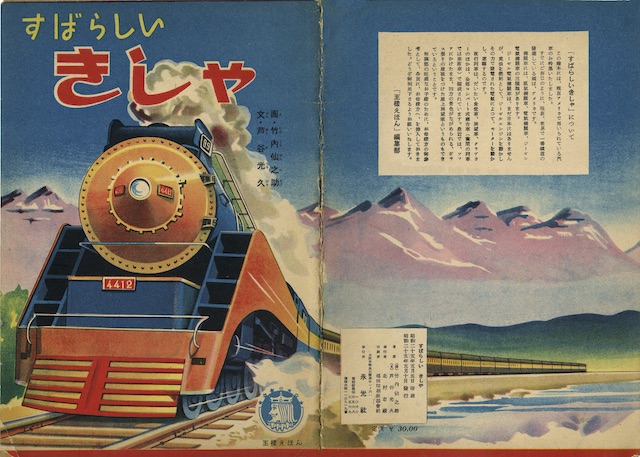
Click image to download an 11.5-MB PDF of this 12-page booklet.
“In this picture book, only the trains that are currently in use in America have been specially collected,” says the cover. “As you already know, the country in which railroads are most developed is America.”
“There are three kinds of locomotives: steam locomotive, electric locomotive and diesel-electric locomotive. Diesel-electric locomotives do not yet exist in Japan. They use heavy fuel oil as fuel to put a diesel engine into motion and use the electricity generated from that power to power motors for operation.
“Most night trains consist of diner, observation car, club car and also full compartment sleeper (coach car for day trains). Recently, it is said, there are elevated observation cars in which passengers can view the scenery of four directions while seated in a sofa.
“To cope with demands from the dear child with strong intellectual interest, we have inserted reference information for honorable mothers in each page. Please make use of this.”
Each of the interior pages have text in large characters for children to chant and smaller characters with more information for “honorable mothers.” I’m including translations for the pages in the order in which the Japanese would read them, which is the opposite from the way we would read them.
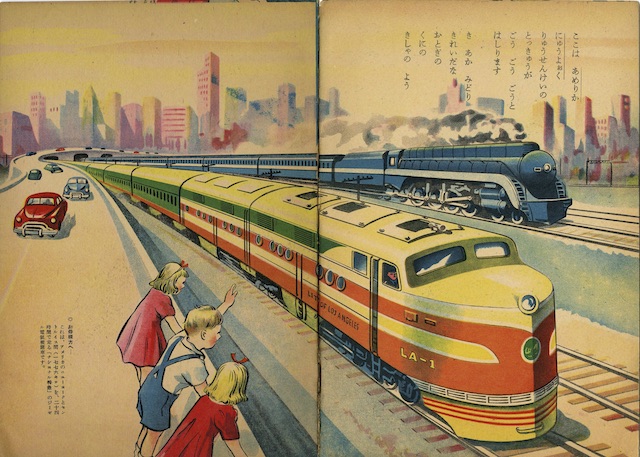
For children: “This is America, New York. Streamlined limited runs gho! gho! gho!
Yellow red green, Pretty it is. Like a train from a fairytale land.”
“To honorable mothers: This is the diesel-electric locomotive of the National Limited which runs between New York and St. Louis (1776 km) in 24 hours.”
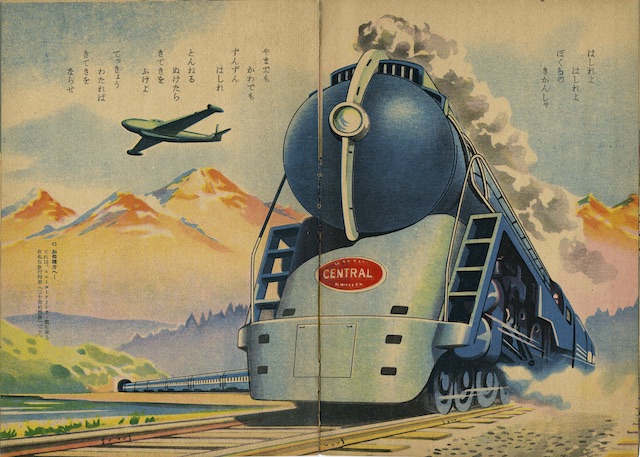
For children: “Run. run, our locomotive. Over mount, over river. Keeping running on.
Out of a tunnel, Blow the whistle. Cross a bridge, sound the whistle.”
“To honorable mothers: This is the famous express train 20th Century Limited which runs between New York and Chicago.”
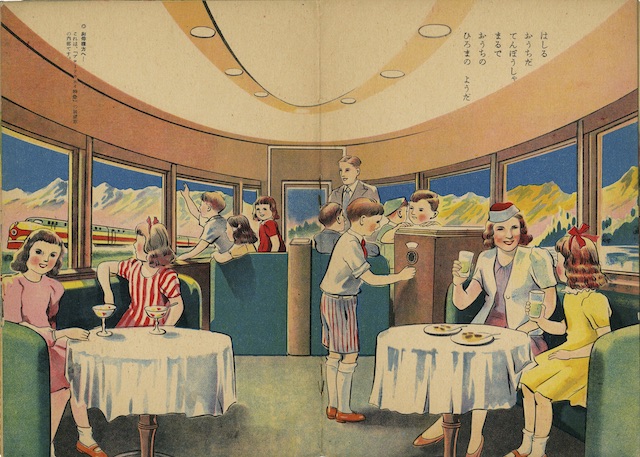
For children: “A house in motion. Observation room. It is like the guest room of a house.”
“To honorable mothers: This is the interior of the observation car of the Broadway Limited.”
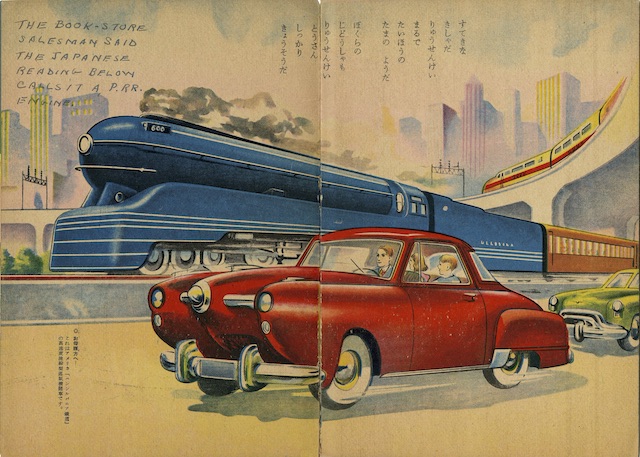
For children: “A fabulous train. Streamlined. It is like a cannon-ball.
Our car is streamlined too. Father hold firm. This is a race.”
“To honorable mothers: This is the high-speed streamlined locomotive of the Pennsylvania Railroad.”
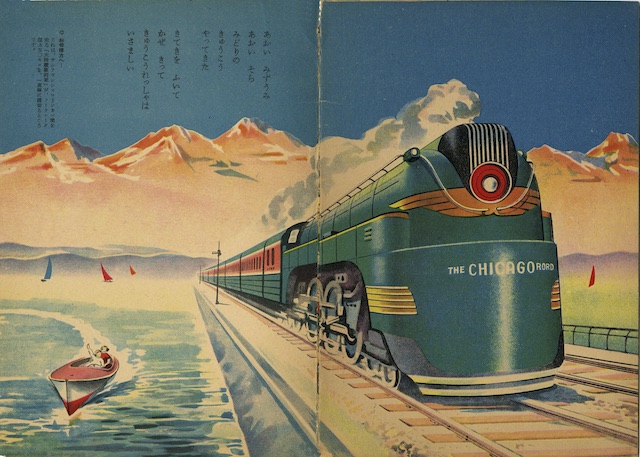
For children: “Blue lake, Blue sky. Green express has come.
Blow the whistle, Rip the wind. The express train is courageous.”
“To honorable mothers: This is the ‘Transcontinental Train’ between San Fransisco – Chicago crossing 50 km over the Salt Lake in one straight line.”
Mr. Urushibata suspects “transcontinental train” is a Japanese mistranslation of “Overland Limited.” He notes that “I owned some picture books from this publisher as a child.” He adds, “It’s interesting to observe how the artist and the writer make up for what they are uncertain of with imagination. I notice that the mountains behind the 20th Century Limited are too tall and the right-of-way has only two tracks.”
The booklet was published in May 1950 with pictures credited to Sennnosuke Takeuchi and text to Teruhisa Ashiya. Even though I couldn’t read it, the bullet-nosed Studebaker on the third spread revealed that it was from around 1950.
Though this was the latest-model Studebaker in that year, and despite the claim that only trains in current use were shown in the booklet, all of the trains are from the late 1930s. This is even true for the one Diesel-powered train, which is identified as the National Limited even though the artist has labeled it City of Los Angeles. The blue steam-powered train in the background looks like Baltimore & Ohio’s Cincinnatian, and if so it is the one post-war train in the booklet (it was inaugurated in 1947).
By 1950, nearly all of the steam-powered passenger trains in the booklet had been Dieselized. The booklet’s reference to “elevated observation cars” obviously means dome cars, but the artist apparently had never seen any and so couldn’t draw one in. Most of what the artist had seen must have been black-and-white photos as many of the colors are wrong.
This isn’t to be critical: the Japanese in 1950 clearly had a lot of respect for the United States (thanks largely to General MacArthur) but limited first-hand information about the country. Though they were a decade out of date, the artist presented some beautiful images of American trains.
The United States still has the world’s best-developed freight rail system. But with the introduction of the Shinkansen in 1964, Japan became the world’s leader in passenger train technology. It’s entirely possible that some children reading this booklet in 1950 were inspired to help design and build, if not the first Shinkansen (which opened when most of them would have been under 20 years old), then later ones.
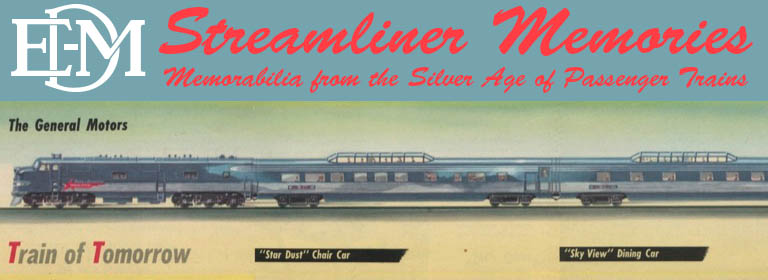
So long as we are turning to the Japanese, perhaps you might like to look at the interurban that took inspiration from the Electroliner?
Or the Great Northern-inspired paint scheme that proliferated across much of the country?
Perhaps you might be interested in the EMU/DMU family whose nose design harkens to the early City streamliners?
Or the interurban that was took inspiration from said family?
If any of these interest you, please respond here, and I can help you gather information (from Wikipedia and beyond) about these various streamliners of the rising sun.
Might it be possible to put this under foreign, so it would be easier to find?